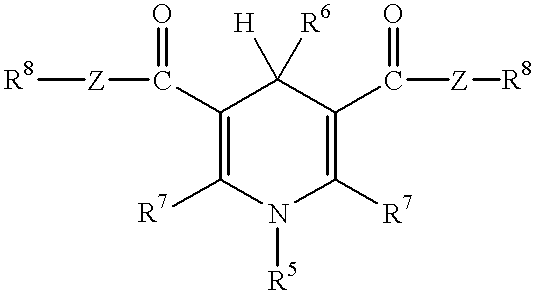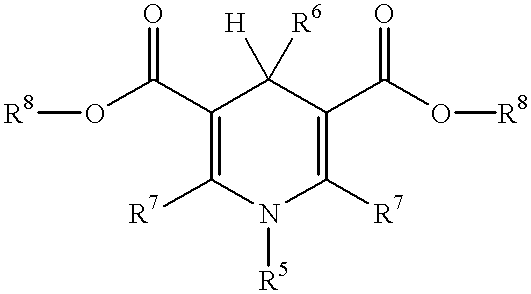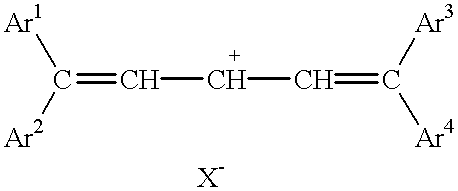Laser absorbable photobleachable compositions
a technology of photobleachable compositions and laser absorbers, which is applied in thermography, instruments, photosensitive materials, etc., can solve the problems of colorant transfer, rapid build-up of heat in exposed areas, and the possibility of contamination of the final image by the laser absorber
- Summary
- Abstract
- Description
- Claims
- Application Information
AI Technical Summary
Problems solved by technology
Method used
Image
Examples
example 1
This example demonstrates the photoreductive bleaching of Dyes 1 and 2 by Compounds 1(a) and 2(i.e., Donors 1(a) and 2). The following formulations were coated on 100 micrometer unsubbed polyester base at 12 micrometer wet thickness and air dried to provide Elements 1-4:
Element 4 is a control (c) as there is no photoreducing agent (i.e., donor) present. Elements 1 and 2 were pale blue / pink in appearance and Elements 3 and 4 pale grey. Samples measuring 5 cm.times.5 cm were mounted on a drum scanner and exposed by a 20 micron laser spot scanned at various speeds. The source was either a laser diode delivering 115 mW at 830 nm at the image plane (Elements 1 and 2), or a YAG laser delivering 2 W at 1068 nm (Elements 3 and 4). The results are reported in the following table in which OD represents optical density:
Element 3 Element 4(c)
In the case of Elements 1-3, colorless tracks were formed in the exposed areas, with the degree of bleaching correlating with scan speed, whereas Element 4...
example 2
This example demonstrates the photoreductive bleaching of Dyes 3 and 4 by Compound 3, which may be regarded as an acyl-protected leuco phenoxazine dye. Elements 5 and 6 were prepared in the same manner as Elements 1-4 from the following formulations:
Laser diode irradiation at a scan speed of 200 cm / second (as described in Example 1) produced the following changes in optical density:
Thus, efficient bleaching of the IR dye was observed, with no significant build up of dye density attributable to the phenoxazine dye corresponding to Compound 3.
example 3
The example demonstrates thermal transfer media in accordance with the invention. A millbase was prepared by dispersing 4 grams of magenta pigment chips in 32 grams of MEK using a McCrone Micronising Mill. The pigment chips were prepared by standard procedures and comprised blue shade magenta pigment and VAGH binder in a weight ratio of 3:2. The following formulations were prepared and coated as described in Example 1 (except the FC was added after the other ingredients had been mixed for 30 minutes under low light conditions) to give Elements 7-10:
(c)=control without donor (not in accordance with invention)
Samples of the resulting coatings were assembled in contact with a VYNS-coated paper receptor and mounted on an external drum scanner with vacuum hold-down, then addressed with a laser diode (830 nm, 110 mW, 20 micrometer spot) scanned at 100 or 200 cm / second. The receptor sheets, after peeling from the donors, showed lines of magenta pigment contaminated to varying extents by Dy...
PUM
| Property | Measurement | Unit |
|---|---|---|
| pKa | aaaaa | aaaaa |
| wavelengths | aaaaa | aaaaa |
| temperatures | aaaaa | aaaaa |
Abstract
Description
Claims
Application Information
 Login to View More
Login to View More - R&D
- Intellectual Property
- Life Sciences
- Materials
- Tech Scout
- Unparalleled Data Quality
- Higher Quality Content
- 60% Fewer Hallucinations
Browse by: Latest US Patents, China's latest patents, Technical Efficacy Thesaurus, Application Domain, Technology Topic, Popular Technical Reports.
© 2025 PatSnap. All rights reserved.Legal|Privacy policy|Modern Slavery Act Transparency Statement|Sitemap|About US| Contact US: help@patsnap.com



